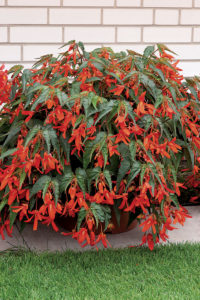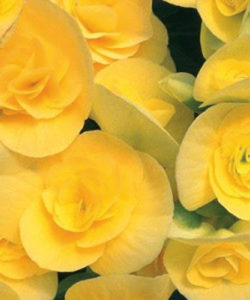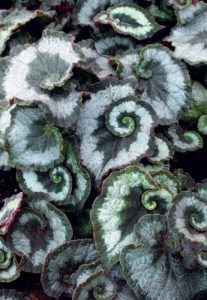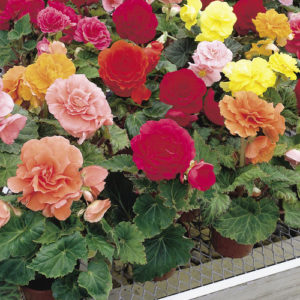
Dragon Wing Red begonia with yellow canna. Pink Baby Wing begonia is in the foreground. (Jo Ellen Meyers Sharp
Begonias are an under appreciated plant. There are so many types, forms and sizes that there’s one for every pot of annuals or in-ground planting scheme. Some thrive, even flower, in deep shade and others burst into bloom in full sun. Leaves can be glossy, bumpy, variegated, patterned, deeply veined, one color on top and another color on the bottom, smooth and fuzzy.
There’s even one that’s winter hardy in our area. Begonia grandis has pink or white flowers in August, but like most begonias, the real beauty is in the leaves—green with red veins on top and greenish-purple on the bottom.

Santa Cruz begonia. PHoto courtesy National Garden Bureau
Most of the begonias we grow though are tropical, and there are a bunch of them. Some of the new hybrids, such as Dragon Wing, Baby Wing, Big, Bada Bing and Bada Boom, are extremely showy with large flowers. These plants tend to be more upright with strong stems. Some have large, glossy, bright green leaves and some have smaller, dark green foliage. These hybrids have leaves that are green or bronze with flowers that are red, pink or white. They do well in full sun to part shade.
The Begonia boliviensis species also can take the sun and tolerates shade. It has a more relaxed, cascading habit and trumpet- or star-like flowers. Santa Cruz Sunset and Bonfire are two popular varieties in this group.
Probably the most common are the wax-leaf or bedding begonias, with the Cocktail series the most readily available.

Amstel Rieger begonia. Photo courtesy Proven Winners
One of my favorites is the Rieger begonia (B. x hiemalis), which has tight, rosette-like flowers in pastels and red. This begonia is very shade tolerant and if deadheaded, retains a clean look throughout the summer. Rieger begonias are also popular houseplants.
Another popular houseplant is the Rex begonia. Over the last few years, these exotic hybrids have escaped their indoor environment to add beauty, texture, unusual blooms and forms in shady outdoor settings. This is the group of plants that has such incredible foliage that flowers are an extra. ‘Escargot’ describes the swirly pattern in the leaves of one Rex begonia.

Escargot Rex begonia. Photo courtesy Annie’s Annuals
My least favorite is tuberous begonia (B. x tuberhybrida), a truly beautiful plant, but one that I find too challenging because the stems are brittle and subject to rotting off.

Non-stop tuberous begonias. Photo courtesy Proven Winners
The popularity of begonias is on the upswing because they are so versatile, something the National Garden Bureau, a trade association of plant breeders, decided to acknowledge in 2016 as the Year of Begonia.